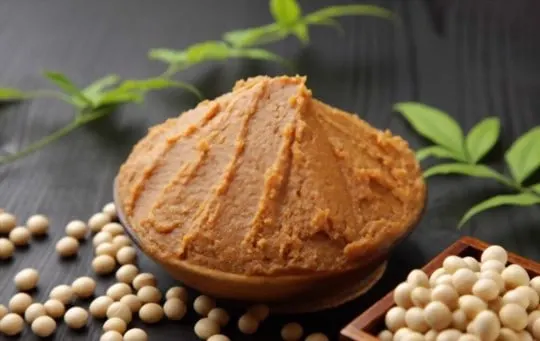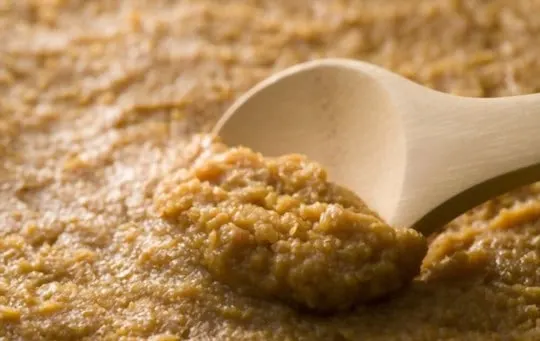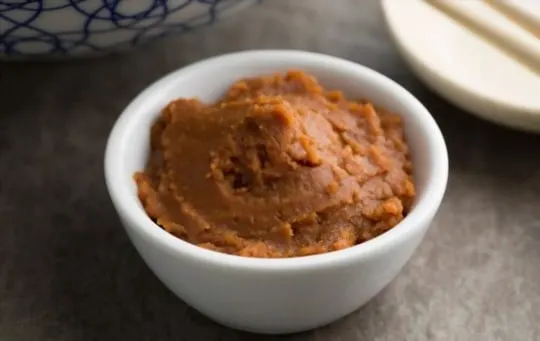Miso paste often flies under the radar in many kitchens.
Yet, this humble ingredient packs a flavor punch unmatched in its versatility.
It’s all about that rich, salty savor that’s hard to put into words.
Think umami, that savory flavor that deepens your dishes, from soups to marinades.
Miso comes from fermenting soybeans with salt and koji, and this process births a taste profile as diverse as its color spectrum.
Whether you’re a seasoned chef or just someone looking to jazz up your meals, miso paste is your ticket to heightened flavors.
Ready to give your cooking an upgrade? Keep reading to unlock the magic of miso paste.
What is Miso Paste?

Miso paste is a popular seasoning ingredient where soybean is fermented with salt and koji.
You can also use barley and rice to make this paste.
The key ingredient required in preparing this paste is koji.
It’s a mold and is scientifically called aspergillus oryzae.
This fungus helps to kickstart the process of fermentation of soybean.
Apart from providing taste and flavor to the dish, this paste is a rich source of vitamin B-12.
It also has a good amount of protein and minerals.
Soybean is a good source of protein, and the fungus breaks this nutrient into amino acids.
This fermented paste has been relished in centuries-old Japanese cuisines, thus becoming a staple ingredient.
Various dishes, including the famous miso soup, are prepared using this paste.
Over the years, this paste has become popular in Asian households and is also relished by people worldwide.
What Does Miso Paste Taste Like?

With salt, one of the main ingredients in miso, it’s typically salty.
However, the flavor and aroma may vary according to the component and how long it’s fermented.
Although this paste is quite smelly, adding it to the dish makes it tastier.
If you’re new, you might not like the smell.
But once you’re used to it, you would want to add this paste to all dishes.
Miso paste has a similar umami flavor, and it tastes sweet, savory, and earthy.
Note that this paste has different variants, and you can expect different flavors and tastes.
- Variants of miso paste.
Red miso: Also known as akamiso, this variant has a higher salt intake and requires more aging time.
It’s darker and has a strong flavor.
White miso: Among the miso types, white miso, also called shiromiso, is the lightest and has a mild flavor.
Mixed miso: In mixed miso, also known as awasemiso, is a combination of red and white miso, providing a strong flavor.
These variants are used for different cooking types.
For instance, white miso is mainly used in salads or light soup.
- The nutrient value of miso paste.
Miso paste is a rich source of vitamins and minerals.
It’s low on fat, making it suitable for people who are on a diet.
Additionally, it’s been revealed that miso is a good source of copper.
Overall, this paste has an excellent nutritional value.
Although it’s high in sodium, having it in moderation will cause fewer implications for your health.
How to Use Miso Paste?

Miso paste is a versatile ingredient and is applicable in various dishes.
Despite its pungent smell, this paste surprisingly enhances the taste and flavor of the dish.
This paste is available in different variants, and it would be best to use according to the dish.
Strong paste-like red miso blends well with stews or braises, while white miso is excellent for making a light dish.
If you’re new to this ingredient, starting with white miso would be good.
It has a mild and sweet flavor, great for marination, sauces, soups, and salad dressing.
Some of the best ways to use this ingredient in a dish are as follows:
- Miso glazed salmon: Glazing salmon gives a sweet and savory flavor, enhancing the overall taste.
- Miso dressing: Along with rice vinegar, honey, and sesame oil, add miso paste to give a rich flavor.
- Miso soup: Add the miso paste with dashi and other ingredients, including vegetables and tofu, to make a nutritious soup.
Note that miso paste has a high sodium content, leading to the risk of blood pressure.
Therefore, it’s advisable to have this paste in moderation.
Ensure that you don’t add excess paste to the dish but balance it out to avoid health risks and enjoy the flavor.
Conclusion
Miso paste is a traditional ingredient used widely in Japanese cuisines, and it’s a versatile paste applicable in various dishes.
This paste comes in different variants offering different tastes and flavors.
It is salty by standard with a pungent smell.
Perhaps, you should start with light miso paste if you’re a beginner and gradually opt for stronger ones.
You will keep craving more once you get used to the flavor.

What Does Miso Paste Taste Like? Does Miso Paste Taste Good?
Ingredients
- Miso paste
- Ingredients from your favorite recipes
Instructions
- Depending on the ingredients used, the cooking method, and the type of dish, the taste of the food can vary greatly.
- Make sure to select a recipe that will elevate the food’s original flavor, and enjoy experimenting with different recipes!

Andrew Gray is a seasoned food writer and blogger with a wealth of experience in the restaurant and catering industries. With a passion for all things delicious, Andrew has honed his culinary expertise through his work as a personal chef and caterer.
His love for food led him to venture into food writing, where he has contributed to various online publications, sharing his knowledge and insights on the culinary world. As the proud owner of AmericasRestaurant.com, Andrew covers a wide range of topics, including recipes, restaurant reviews, product recommendations, and culinary tips.
Through his website, he aims to inspire and educate fellow food enthusiasts, offering a comprehensive resource for all things food-related.

Leave a comment